
Glamis Castle is situated beside the village of Glamis in Angus, Scotland. It is the home of the Earl of Strathmore and Kinghorne, and is open to the public.

Dunnottar Castle is a ruined medieval fortress located upon a rocky headland on the north-eastern coast of Scotland, about 2 miles south of Stonehaven. The surviving buildings are largely of the 15th and 16th centuries, but the site is believed to have been fortified in the Early Middle Ages. Dunnottar has played a prominent role in the history of Scotland through to the 18th-century Jacobite risings because of its strategic location and defensive strength.

Kildrummy Castle is a ruined castle near Kildrummy, in Aberdeenshire, Scotland. Though ruined, it is one of the most extensive castles dating from the 13th century to survive in eastern Scotland, and was the seat of the Earls of Mar. It is owned today by Historic Environment Scotland and is open to the public as a scheduled ancient monument with gardens that are included in the Inventory of Gardens and Designed Landscapes in Scotland.
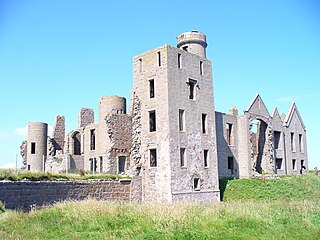
Slains Castle, also known as New Slains Castle to distinguish it from the nearby Old Slains Castle, is a ruined castle in Aberdeenshire, Scotland. It overlooks the North Sea from its cliff-top site 1 kilometre (0.62 mi) east of Cruden Bay. The core of the castle is a 16th-century tower house, built by the 9th Earl of Erroll. Significant reconstruction of the castle has been carried out a number of times, lastly in 1837 when it was rebuilt as a Scots Baronial mansion. At one time it had three extensive gardens but is now a roofless ruin. Plans to restore the castle have been on hold since 2009. It is a Historic Environment Scotland Category B listed building. The castle is linked with the novels of Bram Stoker, including Dracula.
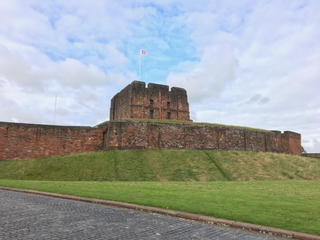
Carlisle Castle is in Carlisle, in the English county of Cumbria, near the ruins of Hadrian's Wall. The castle is over 900 years old and has been the scene of many historical episodes in British history. Given the proximity of Carlisle to the border between England and Scotland, it has been the centre of many wars and invasions. During the Jacobite Rising of 1745–6, Carlisle became the last English fortress to undergo a siege. The castle was listed as a Scheduled Ancient Monument on 7 August 1996.

Hermitage Castle is a semi-ruined castle in the border region of Scotland. It is under the care of Historic Scotland. The castle has a reputation, both from its history and its appearance, as one of the most sinister and atmospheric castles in Scotland.
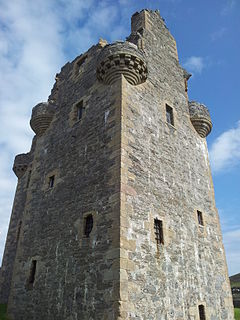
Scalloway Castle is a tower house in Scalloway, on the Shetland Mainland, the largest island in the Shetland Islands of Scotland. The tower was built in 1600 by Patrick Stewart, 2nd Earl of Orkney, during his brief period as de facto ruler of Shetland.
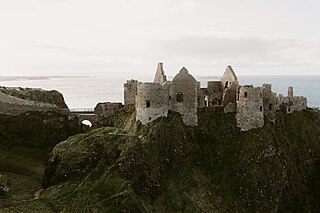
Dunluce Castle is a now-ruined medieval castle in Northern Ireland, the seat of Clan McDonnell. It is located on the edge of a basalt outcropping in County Antrim, and is accessible via a bridge connecting it to the mainland. The castle is surrounded by extremely steep drops on either side, which may have been an important factor to the early Christians and Vikings who were drawn to this place where an early Irish fort once stood.

Crawford Castle, substantially in ruins, is located on the north bank of the River Clyde, around half a mile north of Crawford, South Lanarkshire, Scotland. The ruins stand on an earlier motte and bailey earthwork. The castle is also known as Lindsay Tower, after its former owners, the Lindsay family. The strategic location of the castle, at NS954213, guards the strategically important Mennock Pass from England into the upper Clyde Valley.

Douglas is a village in South Lanarkshire, Scotland. It is located on the south bank of the Douglas Water and on the A70 road that links Ayr, on the West coast of Scotland, to Edinburgh on the East, around 12 miles south west of Lanark. The placename is of Gaelic origin, derived from the Old Gaelic dub and glais, meaning "dark stream", in reference to the Douglas Water. The Douglas family took this name when their ancestors settled here in the 12th century.

Tibbers Castle is a motte-and-bailey castle overlooking a ford across the River Nith in Dumfries and Galloway, Scotland. To the east is the village of Carronbridge and to the north west is a 16th-century country house, Drumlanrig Castle.

Roslin Castle is a partially ruined castle near the village of Roslin in Midlothian, Scotland. It is located around 9 miles south of Edinburgh, on the north bank of the North Esk, only a few hundred metres from the famous Rosslyn Chapel.

Castle Sinclair Girnigoe is located about 3 miles north of Wick on the east coast of Caithness, Scotland. It is considered to be one of the earliest seats of Clan Sinclair. It comprises the ruins of two castles: the 15th-century Castle Girnigoe; and the early 17th-century Castle Sinclair. They are designated as a scheduled monument.
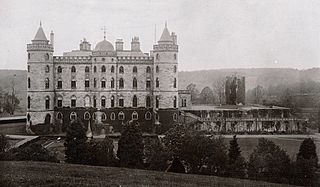
Douglas Castle was a stronghold of the Douglas family from medieval times to the 20th century. The first castle, erected in the 13th century, was destroyed and replaced several times until the 18th century when a large mansion house was built in its place. This too was demolished in 1938, and today only a single corner tower of the 17th-century castle remains. The castle was the former family seat of the Prime Minister, Sir Alec Douglas-Home. The castle was located around 1 kilometre (0.62 mi) north-east of the village of Douglas, South Lanarkshire, in south-west Scotland. The remains are protected as a category C listed building.

Finavon Castle lies on the River South Esk, about a quarter of a mile south of Milton of Finavon village and five miles to the north-east of Forfar in Angus, Scotland. The name is applied both to a ruined 17th-century castle, as well as the 19th-century mansion house 130m to the west.

Carrick Castle is a 14th-century tower house on the west shore of Loch Goil on the Cowal peninsula in Argyll and Bute, Scotland. It is located between Cuilmuich and Carrick, 4 miles (6.4 km) south of Lochgoilhead.

Brahan Castle was situated 3.5 miles (5.6 km) south-west of Dingwall, in Easter Ross, Scotland. The castle belonged to the Earls of Seaforth, chiefs of the Clan Mackenzie, who dominated the area.
Leswalt is a village and civil parish in Dumfries and Galloway, south-west Scotland. It lies between Portpatrick and Stranraer in the Rhins of Galloway, part of the traditional county of Wigtownshire. The parish covers around 8 square miles (21 km2).

Fotheringhay Castle, also known as Fotheringay Castle, was a High Middle Age Norman Motte-and-bailey castle in the village of Fotheringhay 3+1⁄2 miles (5.6 km) to the north of the market town of Oundle, Northamptonshire, England. It was probably founded around 1100 by Simon de Senlis, Earl of Northampton. In 1113, possession passed to Prince David of Scotland when he married Simon's widow. The castle then descended with the Scottish princes until the early 13th century, when it was confiscated by King John of England.
The feudal barony of Cromar was a feudal barony with its caput baronium at Migvie Castle in Aberdeenshire, Scotland. The Earls of Mar held the barony until transferred to the Duke of Fife.


















